Key takeaways:
- Understanding animal behavior and timing is crucial for capturing stunning wildlife photographs.
- Choosing the right gear, particularly a good telephoto lens and stabilization equipment, enhances image quality and preserves the natural behavior of animals.
- Mastering composition techniques, such as the rule of thirds and utilizing negative space, helps create more engaging and storytelling photographs.
- Practicing ethical wildlife photography includes respecting the animals’ well-being, adhering to regulations, and promoting sustainability in nature conservation.
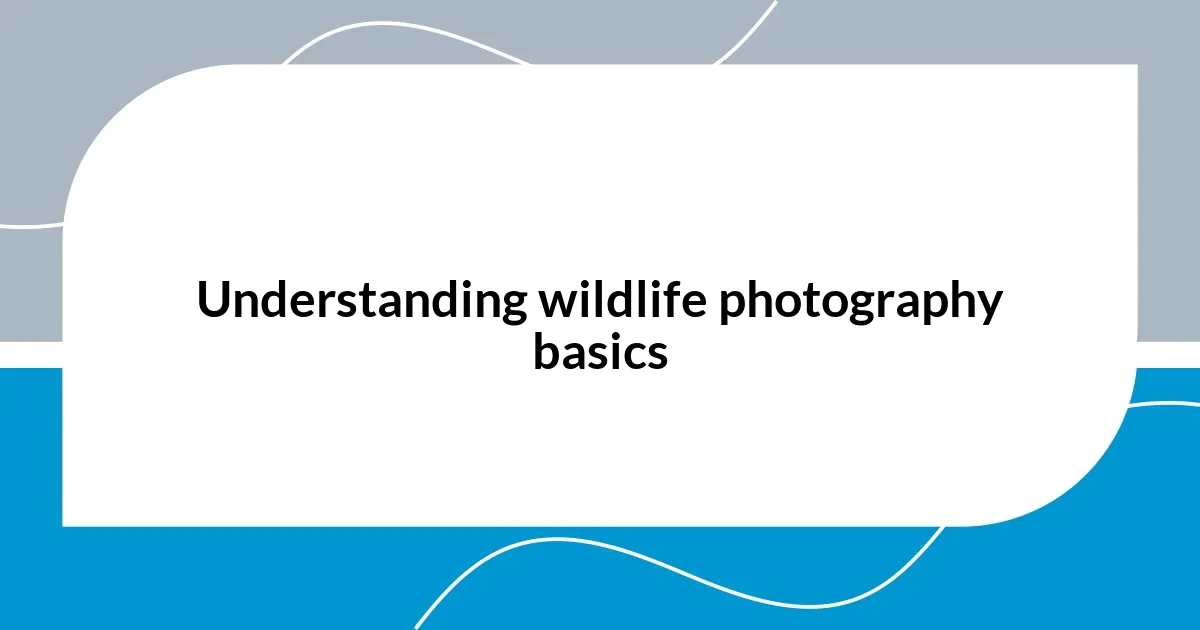
Understanding wildlife photography basics
Wildlife photography begins with understanding the behavior of animals. For instance, when I first ventured out to photograph deer at dawn, I quickly learned that their routines change with the seasons. Watching them graze peacefully in the early morning light made me realize how crucial timing is; capturing those moments requires patience and attentiveness.
Another fundamental aspect that surprised me was the effect of light on the final image. I remember trying to shoot a mischievous squirrel in the golden hour. The warm hues brought out details in its fur that I had never noticed before, transforming a simple capture into something magical. Have you ever considered how natural light can alter your perception? It truly shapes the story you tell through your lens.
Finally, gear choice plays a significant role in wildlife photography. Initially, I was overwhelmed by all the equipment options available. I opted for a good telephoto lens, which changed the way I could approach subjects from a distance. The ability to photograph a soaring eagle without disturbing its natural behavior opened my eyes to a whole new realm of possibilities. What gear have you found to be essential for your own photography adventure?
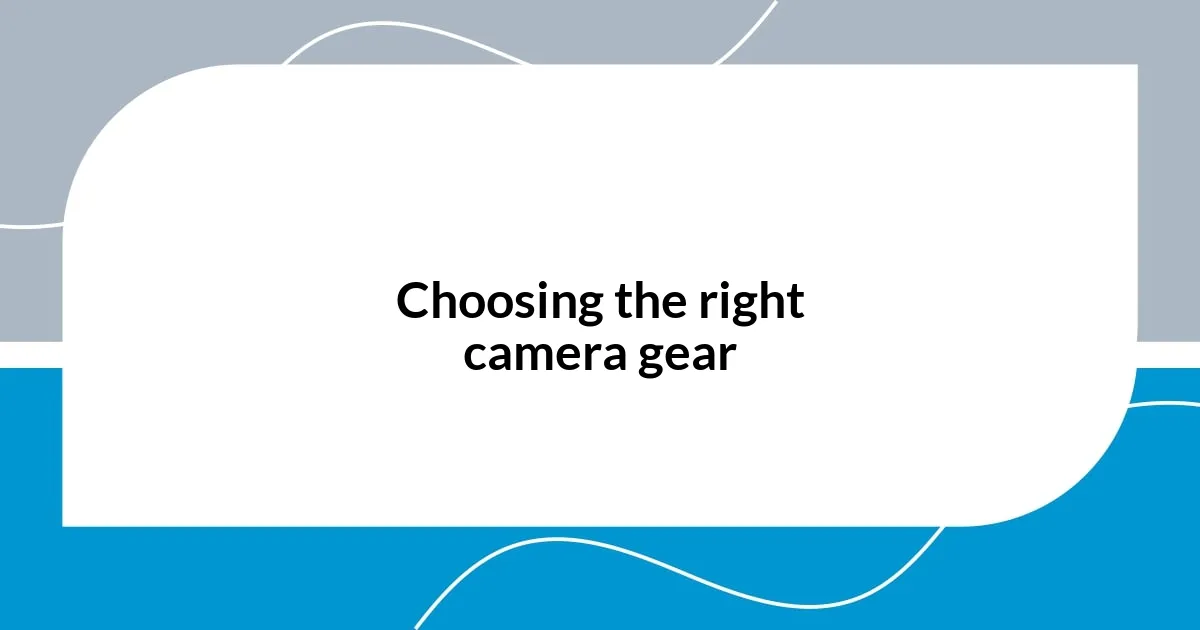
Choosing the right camera gear
Choosing the right camera gear is essential for capturing the beauty of wildlife. I remember my first wildlife outing with a basic DSLR and a kit lens. The limitations struck me immediately; the close-up shots I envisioned were simply out of reach. It was a humbling experience to realize that the right tools can make all the difference, transforming a decent photo into a breathtaking image.
After some research and experience, I decided to invest in a good telephoto lens. The difference was night and day. When I captured my first image of a majestic heron at a distance, I felt an electrifying rush. That moment reaffirmed to me how crucial careful gear selection is for achieving the desired image quality while maintaining the animal’s natural behavior. Which lens do you think you might need for your adventures in wildlife photography?
In addition to lenses, stabilization is another critical factor. I once tried to photograph a bear cub while perched on a shaky rock. Without appropriate stabilization, my shots were blurry and unusable. After that experience, I invested in a sturdy tripod, which has since become my best friend in the field. It allows me to compose images carefully without the stress of camera shake.
| Gear Type | Importance |
|---|---|
| Telephoto Lens | Essential for capturing distant subjects without disturbing them. |
| Tripod/Monopod | Helps stabilize your camera, especially in low light or with heavy lenses. |
| Camera Body | A DSLR or mirrorless camera is crucial for versatility and quality. |
| Camera Bag | Protects your gear during transport and in the field. |
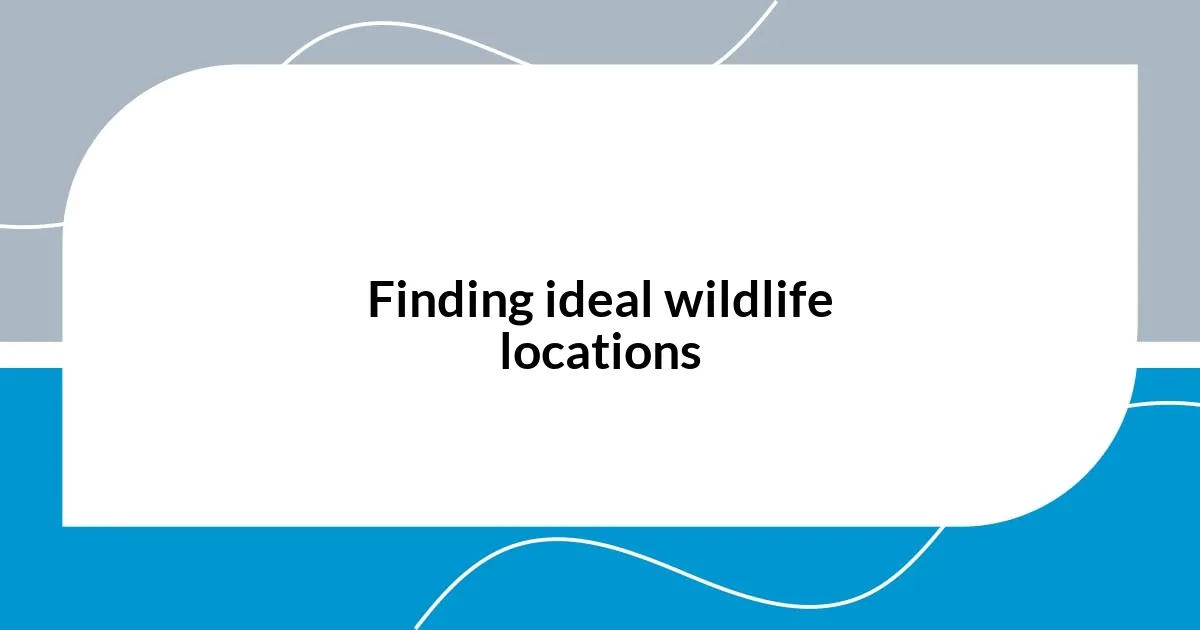
Finding ideal wildlife locations
Finding ideal wildlife locations is both an art and a science. Over time, I’ve discovered that the best spots often find me rather than the other way around. For instance, one afternoon, I stumbled upon a hidden wetlands area on a hike. As I listened to the chorus of frogs and the gentle rustling of reeds, I felt an immediate connection with the natural surroundings. The following weeks spent there revealed a rich tapestry of wildlife, reminding me that sometimes, the greatest discoveries come from simply wandering off the beaten path.
Here are some key tips for uncovering prime wildlife photography locations:
- Research local ecosystems: Understanding the types of habitats nearby can lead you to diverse species.
- Explore at different times: Wildlife behavior varies with the time of day; dawn and dusk are often the most active.
- Utilize online forums and maps: Platforms like iNaturalist or local birdwatching groups can point you to popular wildlife hotspots.
- Check seasonal patterns: Certain locations might be teeming with life during specific seasons, like migration periods.
- Be patient and observant: I once spent hours in a quiet spot before I spotted a family of foxes; sometimes, it’s all about waiting.
With these strategies, you can enhance your journey into the wilderness, increasing your chances of capturing those breathtaking moments in nature.
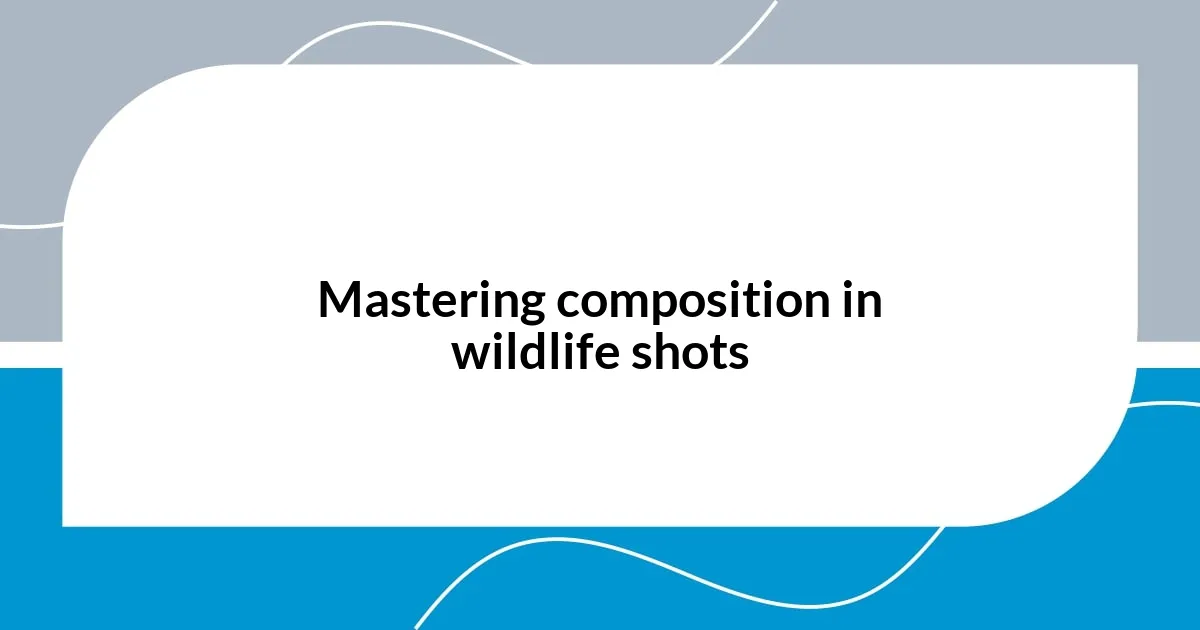
Mastering composition in wildlife shots
Mastering composition in wildlife shots is a lesson I learned through trial and error. I vividly remember my initial attempts were filled with overexposed skies or subjects awkwardly centered in the frame. I was fortunate to find a local photography workshop where an expert demonstrated the rule of thirds. This simple concept transformed my approach overnight. Instead of placing the wildlife dead center, I started to position them along the intersecting lines, which instantly brought my images to life. Have you tried experimenting with different compositional techniques in your photography?
When I stumbled upon a pride of lions basking in the golden light of late afternoon, I felt a rush of excitement. To capture the essence of the moment, I instinctively adapted my composition, framing the majestic animals against a backdrop of acacia trees. By using the natural elements around me, I was able to create context, adding depth to the narrative of the photograph. The subtle balance between the lions and their environment taught me that effective composition is not merely about aesthetics but about storytelling.
Negative space is another element that has profoundly impacted my wildlife photography. I once captured a solitary elephant walking against an expansive savannah backdrop, and it struck me how the empty space emphasized the majesty of the creature, highlighting its isolation in a vast world. This moment was a reminder that sometimes less is more. Have you ever thought about how negative space can enhance the emotional impact of your images? By being thoughtful about composition, I find that each photograph can evoke a deeper connection for the viewer.
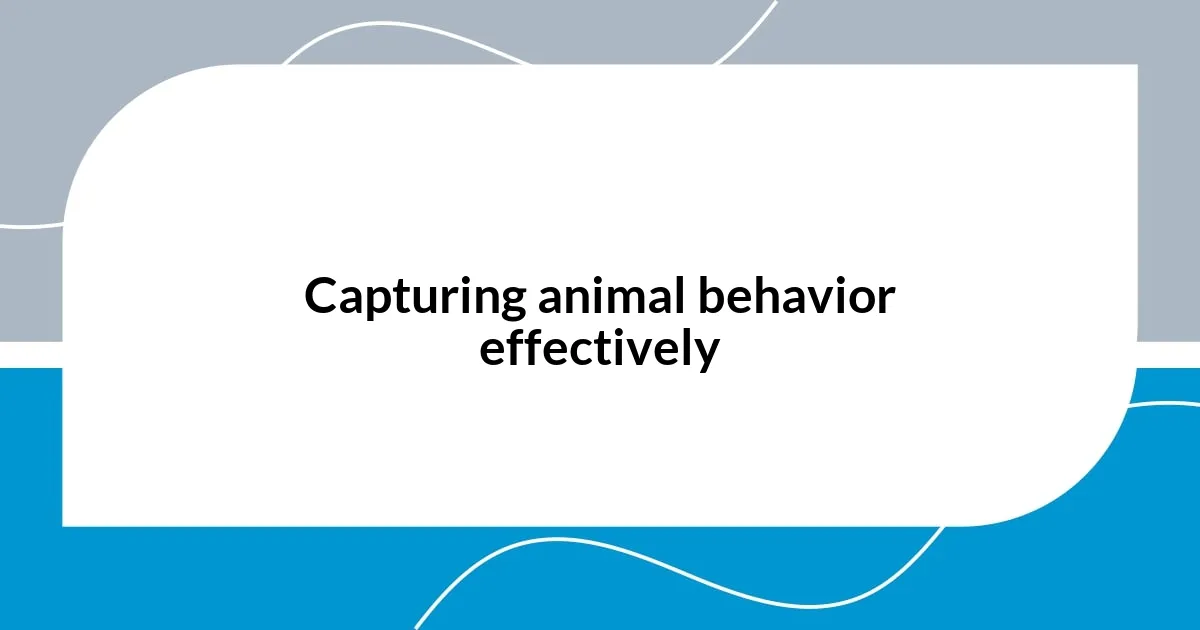
Capturing animal behavior effectively
Capturing animal behavior effectively requires a keen sense of timing and patience. I still recall one early dawn when I parked my car near a riverbank, eagerly waiting for a glimpse of a heron. As the sun began to rise, the serene atmosphere was interrupted by the heron’s graceful movements, skillfully hunting for breakfast. That moment taught me the importance of anticipation. Have you ever found yourself holding your breath, waiting for that perfect action shot? It’s in those fragile seconds that the magic unfolds.
Understanding animal behavior also plays a crucial role in getting those striking images. For instance, I invested time studying the social habits of a troop of monkeys I encountered during a trip to a national park. Observing their interactions—how they groomed each other or played with the young ones—taught me when to click my shutter for the most intimate moments. It’s fascinating, isn’t it, how a little research can guide your intuition in the field?
I often think about the unpredictability of wildlife and how it shapes my photography journey. There was a time I was photographing a family of deer, and just as I positioned my camera, a sudden rustle in the bushes startled them. They darted off with grace and speed, and yet, that unexpected moment became my most cherished photo. The unexpected is what keeps us on our toes, right? Embracing these surprises in animal behavior not only tests our skills but also enriches the stories we capture through our lenses.
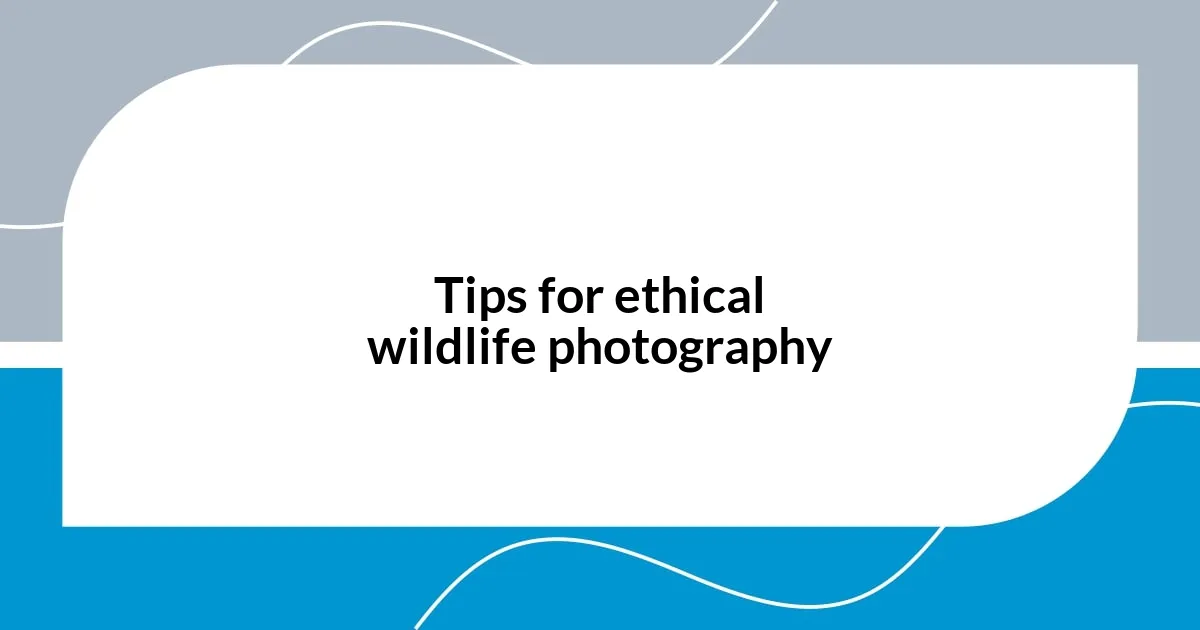
Tips for ethical wildlife photography
When diving into ethical wildlife photography, I’ve learned that respect for the animals and their habitats is paramount. During one of my trips, I found myself tempted to get closer to a family of foxes. However, I chose to keep my distance, recognizing the stress my presence could cause. It’s crucial to remember that our desire for a great shot should never come at the expense of an animal’s wellbeing. Have you ever felt that tension between wanting to capture the perfect image and ensuring you don’t disturb wildlife? It’s a balancing act that I strive to maintain.
Moreover, I’ve found that understanding and adhering to local regulations is vital. I once visited a national park that had specific guidelines about drone usage. At first, I felt frustrated, wanting to capture sweeping aerial shots of breathtaking landscapes. But I soon realized that these rules protect both the wildlife and the environment. Educating ourselves about these regulations not only fosters better practices but also promotes a culture of responsible photography. Have you considered how your knowledge of these guidelines could enhance your own photography experience?
Finally, I can’t stress enough the importance of leaving no trace behind. Last summer, while hiking through a breathtaking forest in search of elusive bird species, I stumbled upon litter left by other visitors. The experience was disheartening, and it ignited in me a desire to advocate for clean nature. Each time I venture into the wild, I make sure to carry extra trash bags, and I encourage fellow photographers to do the same. After all, caring for our planet ensures that future generations can enjoy these awe-inspiring moments just as we do. What small steps can you take to promote a more sustainable approach in your wildlife photography?
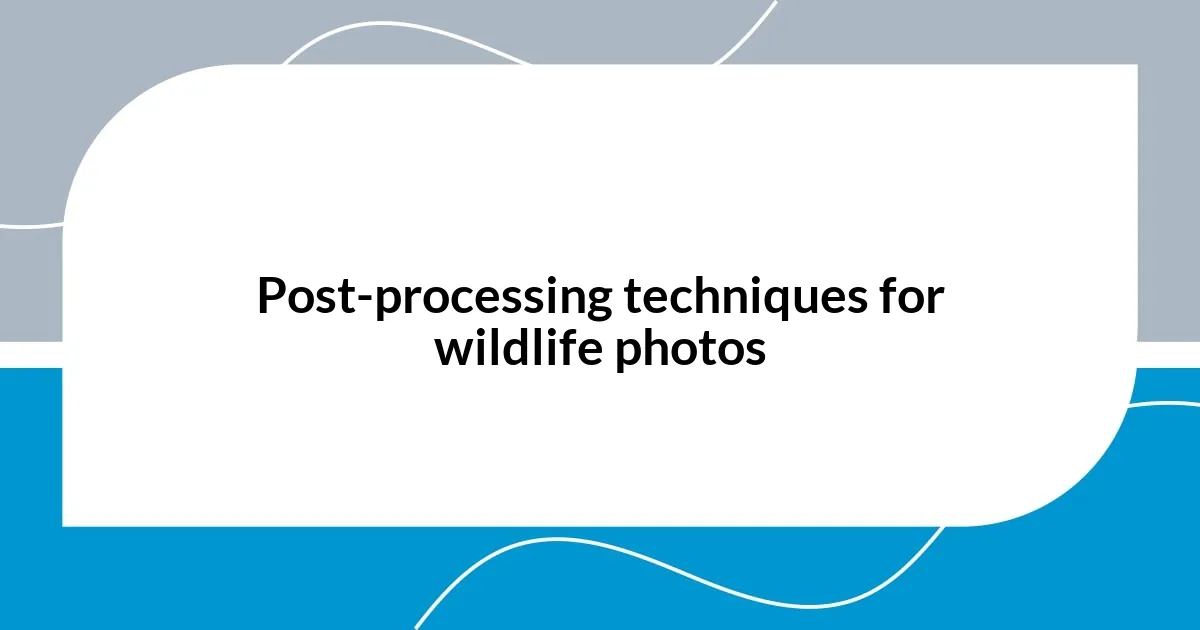
Post-processing techniques for wildlife photos
The magic of post-processing lies in enhancing the story behind the shot. I remember sitting at my desk after a long day of shooting, feeling a mix of exhaustion and excitement as I opened my editing software. With a few adjustments to the contrast and exposure on a close-up of a falcon, that image transitioned from a mere photograph to a breathtaking portrayal of nature’s beauty. Isn’t it amazing how a little editing can breathe new life into a captured moment?
Saturation and sharpening are other aspects I’ve come to appreciate over time. For instance, while working on an image of a lion basking in the golden evening light, I boosted the colors just enough to convey the warmth of the scene without making it look artificial. It was like adding a sprinkle of magic—suddenly, the photo felt vibrant and alive! How do you envision your images? Are you aiming for realism, or do you enjoy creating a more artistic representation? Finding that balance can truly elevate your work.
Recently, I delved into using selective editing techniques. I recall editing a chaotic scene of a herd of elephants on the move, filled with dust and excitement. By applying a vignette effect around the edges, I guided the viewer’s focus towards the elephants in the center, enhancing the drama of the moment. It was a revelation! What tools do you utilize in your creative process? Embracing post-processing as a storytelling technique can transform your wildlife photos into compelling narratives.